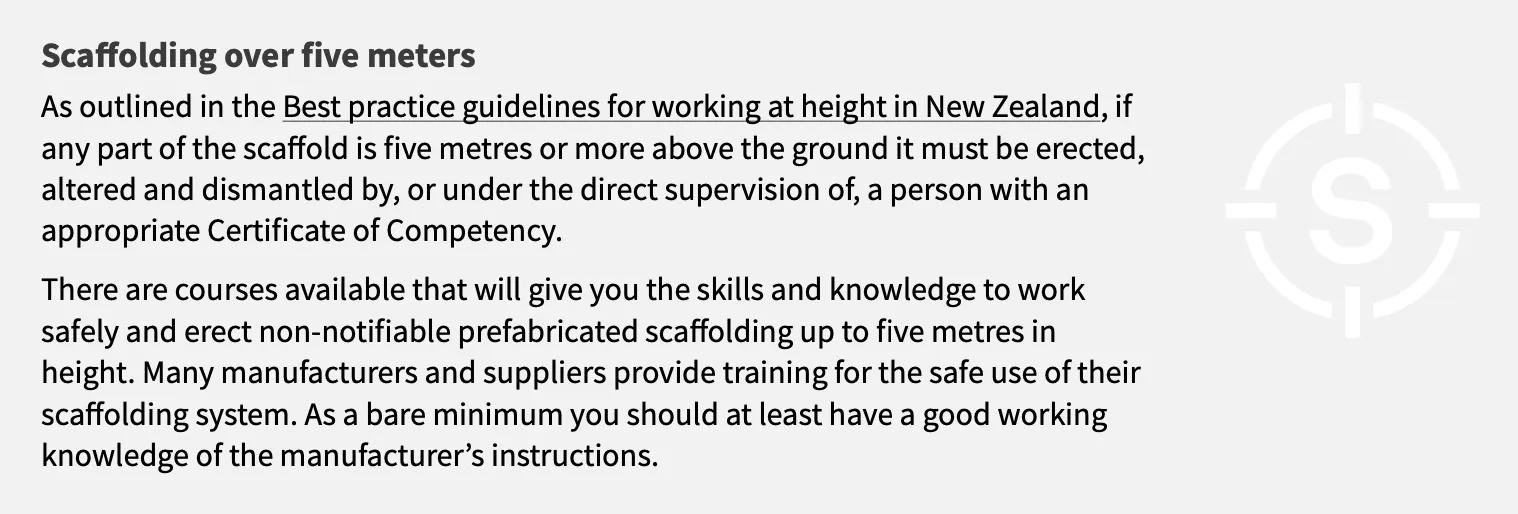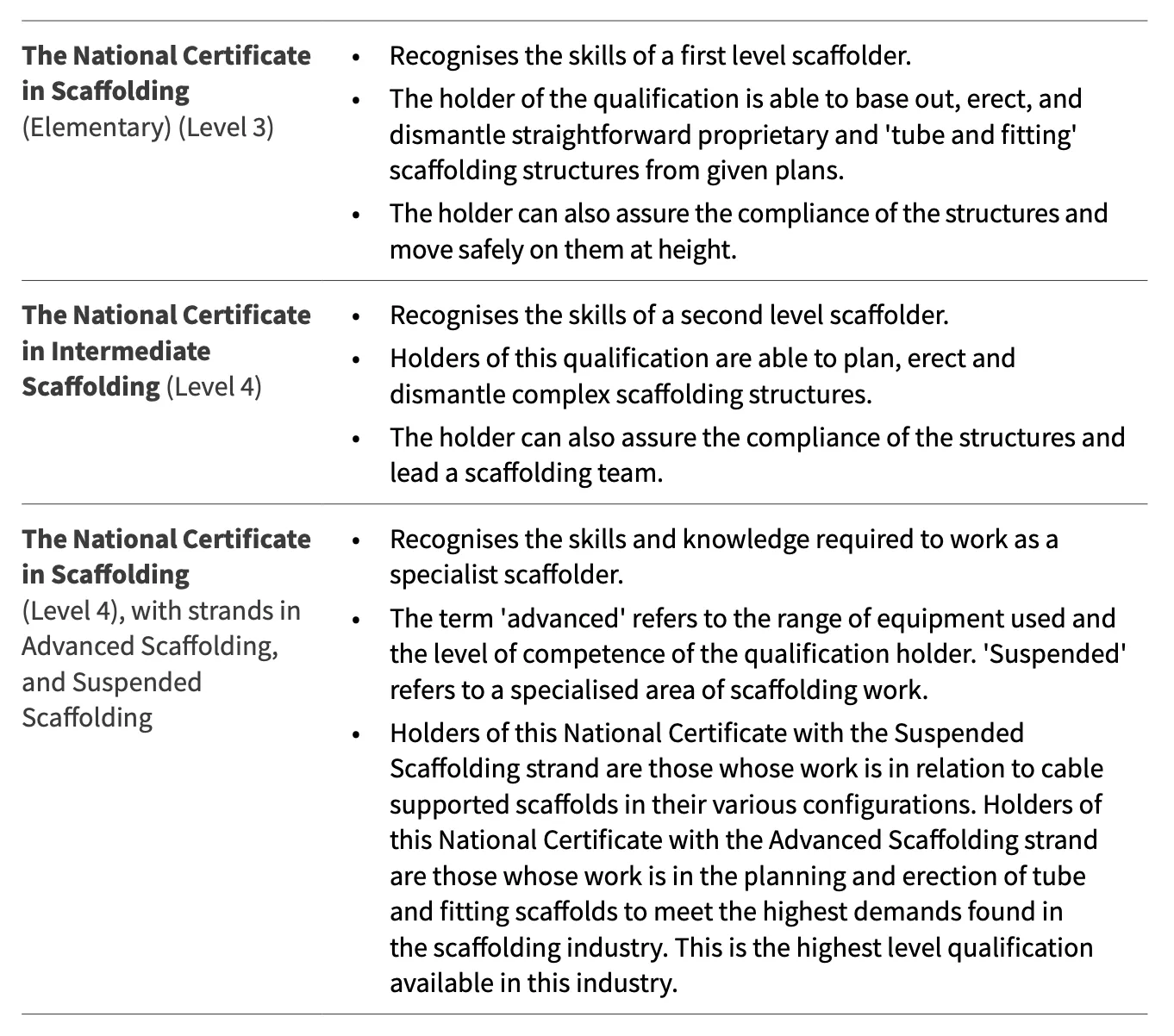Working at Height - Scaffolding
Te Mahi ki ngā Tiketike- Tīrewa

Scaffolding
This chapter relates to the chapter on working at heights and provides guidance on using scaffolding on a production set. It is primarily based on New Zealand legislation and guidance issued by WorkSafe NZ.
Who needs to read this?
All workers who undertake tasks using scaffolding should read and understand the section on minimum responsibilities.
Roles that have specific responsibilities, or influence, over setting up or managing work conducted using scaffolding should read the section on ‘planning and guidance considerations’ – this includes producers, directors, production managers, art directors, construction managers, heads of departments, assistant directors and health and safety advisers.
Definitions
Scaffolding is any advanced scaffolding, basic scaffolding or suspended scaffolding or any framework or structure, of a temporary nature, used or intended to be used for:
- the support or protection of persons carrying out construction work or work connected with construction work, for the purpose of that work; or
- the support of materials used in connection with any such work, and includes:
- ~any scaffolding constructed as such and not dismantled, whether or not it is being used as scaffolding; or
- ~any coupling device, fastening, fitting, or plank used in connection with the construction, erection or used of scaffolding.
Scaffolding process is the planning for and/or the design, erection, inspection, alteration, use or dismantling of any scaffolding and/or related components.
This includes all structures constructed using scaffolding components, such as falsework, temporary grandstands, lighting towers and stair access towers.
What risks do I need to look out for?
- Falls
- Collapse of the structure
- Equipment falling from the structure
- Wind
Minimum responsibilities
Everyone who undertakes tasks using scaffolding should read and understand this section.
Workers should:
- ensure equipment being ferried up and down is properly secured and belayed;
- secure equipment being used on the scaffolding;
- leave mobile scaffolding if it is being moved; and
- only erect, alter and dismantle scaffolding if they have been adequately trained and have suitable experience with the type of scaffolding being used – see the section on training below for more information.
Planning and guidance considerations
Everyone who has responsibilities, or influence, over setting up or managing work conducted using scaffolding should read and understand this section, as well as the minimum responsibilities for everybody.
This includes the production company, producers, directors, line producers, art directors, construction managers, heads of departments, assistant directors and health and safety advisers
Person in charge
The person in charge / those with responsibilities, or influence, over setting up or managing work conducted using scaffolding should ensure all scaffolding:
- is used for the purpose for which it was built;
- complies with the Scaffolding, Access & Rigging New Zealand (SARNZ) Best Practice Guidelines for Scaffolding in New Zealand or equivalent guidelines or a higher standard;
- is erected, altered and dismantled by persons who have been trained and have suitable experience with the type of scaffolding being used;
- from which a person or object could fall more than five metres, as well as all suspended scaffolds, is:
- ~ erected, altered and dismantled by or under the direct supervision of a person with an appropriate certificate of competency;
- ~ this work must be notified to the Ministry of Business, Innovation and Employment as particularly hazardous work;
- has a minimum clearance of four metres from overhead live electric power lines.
They must also:
- ensure that if a scaffold is altered, modified, tampered with and/or appears to be unsafe, the scaffold is not used until it has been checked and certified as safe by a competent person as outlined in the SARNZ Best Practice Guidelines for Scaffolding in New Zealand;
- know the safe working load of the scaffolding and adhere to it;
- always consider the effect of the weather on the use of scaffolding in particular wind.
All scaffolding should have:
- safety rails to prevent falls, with a mid-rail if higher than three metres; and
- ladders fixed in place – only ladders should be used for climbing.
Training
The PCBU, likely to be the production company, must ensure workers are either sufficiently experienced to do their work or are adequately supervised by an experienced person, as well as adequately trained in the safe use of equipment in the workplace.
Anyone erecting scaffolding should:
- be competent (or in the case of trainees, supervised by a competent person) for the type of scaffolding work they are undertaking; and
- have received appropriate training relevant to the type and form of scaffolding they are working on.

Mobile scaffolding
Where work is performed using mobile scaffolds, the scaffold should be erected by a competent person and used in accordance to the manufacturer’s specifications.
Certificates of competency
Certificates of competence are issued by Scaffolding, Access & Rigging New Zealand Inc (SARNZ)5 under delegated authority from WorkSafe NZ.
To be issued with a certificate of competence individuals need to provide evidence of:
- training to national certificate level or an equivalent international qualification; and
- recent relevant industry experience; or
- holding a current certificate of competence requiring renewal and meeting the requirements of regulations 31 and 35 of the HSE Regulations 1995.
Ongoing certification requires continued involvement in the industry and proof of continued competence.
National certificates


